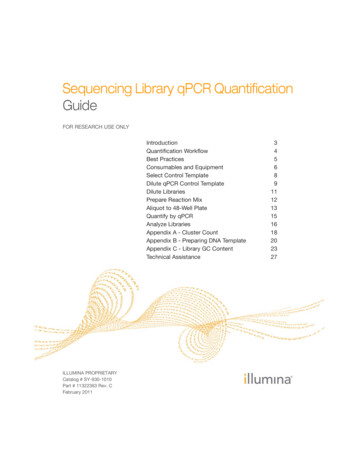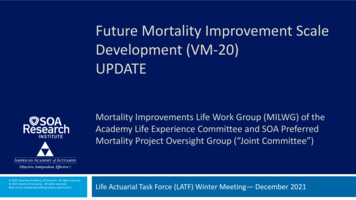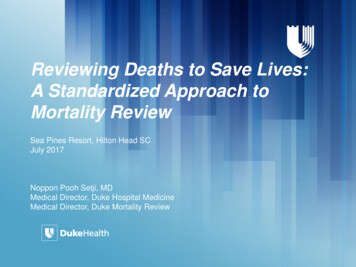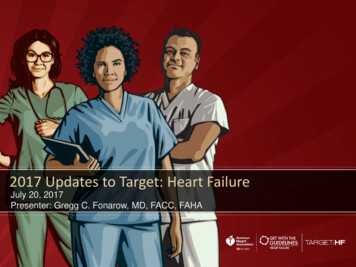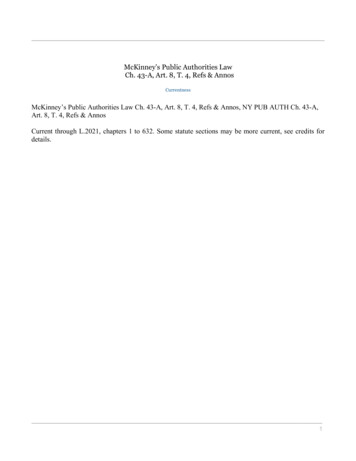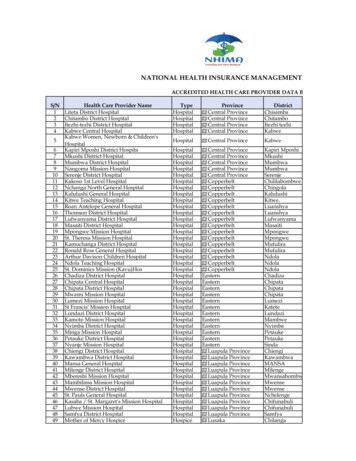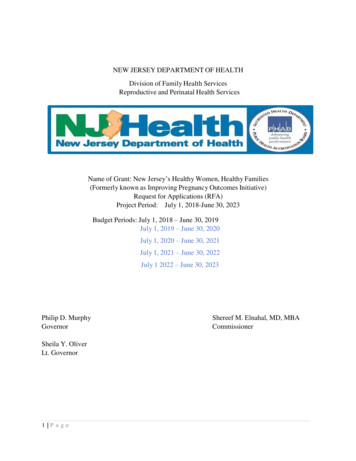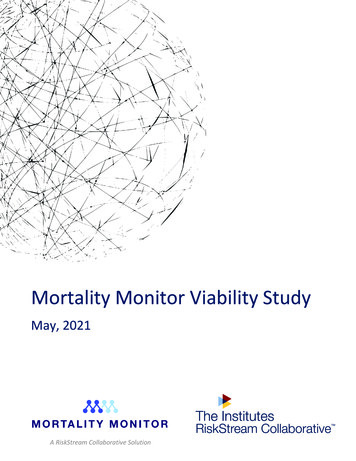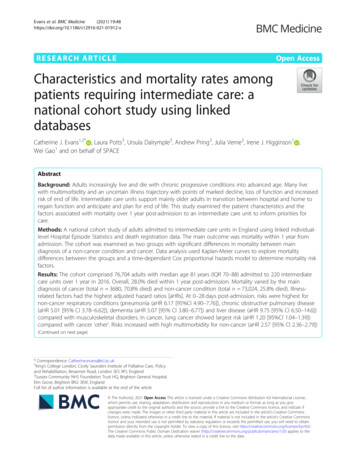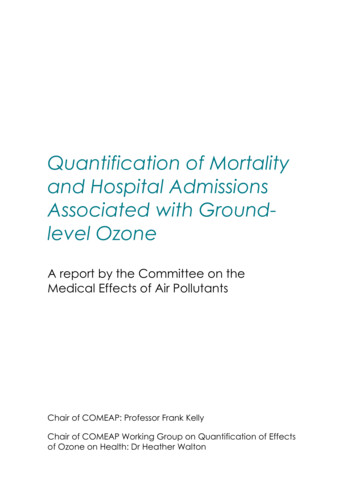
Transcription
Quantification of Mortalityand Hospital AdmissionsAssociated with Groundlevel OzoneA report by the Committee on theMedical Effects of Air PollutantsChair of COMEAP: Professor Frank KellyChair of COMEAP Working Group on Quantification of Effectsof Ozone on Health: Dr Heather Walton
Crown copyright 2015Produced by Public Health England for theCommittee on the Medical Effects of Air PollutantsISBN 978-0-85951-776-8
ForewordSummertime ozone exposure represents a substantial health risk to the UK population. As asecondary pollutant, ozone is highly sensitive to anthropogenic and natural precursor emissionsas well as prevailing atmospheric conditions and is likely to be influenced by climate change.Current assessments on mortality/morbidity burdens in the UK are based on short-termexposure coefficients initially proposed by the Committee on the Medical Effects of AirPollutants (COMEAP) in 1998 and updated by the World Health Organization (WHO) in2004. As annual mean ozone concentrations are increasing in some urban areas in the UK,Public Health England asked COMEAP to reconsider the quantification of health effectslinked with ozone, in preparation for the 2nd National Climate Change Risk Assessment to bepresented in Parliament in early 2017.With a suggested reporting deadline of mid-2015, COMEAP formed a working group toundertake this task. I am extremely grateful to its members, who chaired byDr Heather Walton, performed this task in a matter of months and produced several draftreports for COMEAP and the secretariat to consider.The report makes several important conclusions about the short-term health effects of ozone.Unsurprisingly, given the short timeline in place, the working group identified several areaswhich could not be resolved. A number of these arose because the evidence base is stillinsufficient to allow a reliable conclusion to be drawn at this time. Helpfully, the reporthighlights these gaps and deficiencies and makes recommendations for future research.Ground-level ozone remains one of the most pervasive ambient pollutants, not only affectinghuman health, but also food production and the environment. However, as has beenhighlighted in this report, important gaps in our knowledge remain and uncertainties exist.With climate change potentially influencing availability of ozone precursor gases, as well asclimatic conditions that favour its formation, it is now crucial to improve our understanding ofthe health impacts of this strongly oxidising ambient pollutant.Professor Frank KellyChair of the Committee on the Medical Effects of Air Pollutantsiii
AcknowledgementsThe COMEAP Working Group on Quantification of Effects of Ozone on Health would liketo thank Barbara Butland for undertaking the systematic review on the long-term exposureappendix, contributing to the analyses and writing.v
Executive SummaryAKey pointsaThis report was prepared to feed into the evidence base for the 2nd NationalClimate Change Risk Assessment. It is a combination of (i) recommendationsand (ii) suggestions of a strategy for research to develop theserecommendations further over timebThere is sufficient evidence to recommend quantification of the impacts ofshort-term exposure to daily maximum 8-hour running mean ozone on allcause mortality, respiratory hospital admissions and, acknowledging moreuncertainty, cardiovascular hospital admissions, in the core analysis of a healthimpact assessment. The evidence suggests it is reasonable to assume nothreshold for any of the health endpoints considered here in a health impactassessmentcThe recommendations given here are for the purpose of planned health impactassessment for current and future scenarios that do not cover other pollutants.Also, it is likely that correlations with other pollutants may continue to besimilar in the future. Therefore, the use of a concentration-response functionbased on single-pollutant models was considered, on balance, to be thebest optiondWe have not considered (i) panel study evidence on effects of ozone onreduced lung function, as this effect is difficult to value in cost-benefit analysis;(ii) other respiratory symptoms, for which evidence is difficult to synthesise;or (iii) restricted activity days, which will be considered in a separate pieceof workeThe evidence from all-year associations between long-term exposure to ozoneand mortality is not convincing. There is limited evidence for an associationbetween ozone concentrations during the warmer months of the year. Furtherwork is required on the assumptions needed for health impact calculations(thresholds, effect modification, cessation lags and life table methods forapplying risks for part of a year). We do not therefore recommendquantification of effects of long-term exposure to ozone and mortality at thisstage. We recommend further work in order to develop quantificationapproaches for use in sensitivity analyses in the futurefInterpretation of evidence on ozone is complicated by changes in correlationsbetween pollutants by season and possible interactions with temperature. Afuture research strategy to improve understanding is suggestedvii
Quantification of Mortality and Hospital Admissions Associated with Ground-level OzonegThe concentration-response coefficients recommended for quantification incore analysis are given belowShort-term exposureHealth endpointConcentration-response coefficient: %increase per 10 µg/m3 daily maximum 8-hourrunning mean ozone (95% confidence interval)0.34% (0.12, 0.56%)0.75% (0.30, 1.20%)0.11% (–0.06, 0.27%)All-cause mortality, all agesRespiratory hospital admissions, all agesCardiovascular hospital admissions, all agesLong-term exposureNot recommended for quantification at this stage; pending further workBIntroductionClimate change has the potential to increase ground-level ozone concentrations and this needsto be taken into account when assessing the risks of climate change overall. The Committee onthe Medical Effects of Air Pollutants (COMEAP) was requested by Public Health England togive an updated opinion on the quantification of health effects of ozone, for use in the2nd National Climate Change Risk Assessment (CCRA2). COMEAP formed a working groupwhich reviewed the available evidence on appropriate concentration-response functions anddrafted this report. The report has been endorsed by COMEAP.Broadly, the terms of reference request advice, with reference to quantification of health effectsin the UK, on:aWhether the evidence is sufficient to support quantificationbConcentration-response relationships for short-term exposure to ozone andmortality and hospital admissions, for application in the UKcConcentration-response relationships for long-term exposure to ozone andmortalitydIssues affecting the interpretation and/or application of the above, such asindependence from other pollutants, thresholds, interaction with temperature,effect modification, ozone metric and use or not of seasonal resultsThis report is a combination of (i) recommendations and (ii) suggestions of a strategy forresearch to develop these recommendations further over time. Our recommendations can alsobe used for purposes other than the CCRA2. The conclusions could change as a result offurther work.This report concentrates on ground-level ozone. This is not the only pollutant affected byclimate change – further work is recommended on other pollutants.The report is structured in three parts at different levels of detail. This summary presents ourconclusions as responses to particular questions, with cross-references to paragraphs in themain report. The main report sets out the reasoning behind the conclusions. Finally, there is aseries of appendices that give fuller technical details behind this reasoning.viii
Executive SummaryCEffects of short-term exposure (Chapter 3)Q1For which health endpoints is there sufficient evidence of causalassociations with short-term exposure to ambient concentrations ofozone for these endpoints to be quantified?We concentrated on evidence from population-based epidemiological studies (important forhealth impact assessment), and focused on studies relating to the general population ratherthan susceptible groups.We have not considered panel study evidence on the effect of ozone on reduced lung function,as this effect, while well established, is difficult to value in cost-benefit analysis. There isevidence from panel studies for associations between ozone and respiratory symptoms but it isdifficult to systematically summarise and synthesise this evidence due to variation in the exactdefinitions of study populations and symptom descriptions. Restricted activity days are beingconsidered as an outcome for quantification separately but the evidence base for ozone andrestricted activity days is very small. Instead we have concentrated on time-series studies thatare able to pick up more serious disease outcomes.Within the time-series studies, we examined studies on broad health outcomes for all ages:all-cause mortality, cardiovascular hospital admissions and respiratory hospital admissions(Sections 3.1–3.5). Associations with all-cause mortality have been examined in a larger numberof studies covering a larger number of locations. Quantifying cause-specific mortality inaddition to all-cause mortality would result in double-counting.For admissions, we again chose broad health outcomes for all ages (all respiratory and allcardiovascular admissions) as, for all ages, there are many more studies on the broader diagnoses.Meta-analyses from a Department of Health funded systematic review (Atkinson et al., 2014)gave positive associations with all-cause mortality, all ages for all three averaging timesconsidered1, although the lower confidence interval was marginally below zero for dailymaximum 1-hour mean ozone. The all-cause mortality evidence was supported by evidencefrom a smaller number of studies for associations with both cardiovascular mortality andrespiratory mortality.For all respiratory admissions, for all ages, positive associations were again found for allthree averaging times, although the lower confidence interval spanned zero for daily maximum1-hour mean ozone. This was supported by evidence of positive associations with confidenceintervals above zero for all respiratory admissions in adults (daily maximum 1-hour and 8-hourmean), and in children (8-hour mean ozone2 but not daily maximum 1-hour mean). Positiveassociations were also found for common respiratory sub-diagnoses (eg asthma in adults, lowerrespiratory infection and chronic obstructive pulmonary disease or COPD).1 Daily maximum 1-hour mean, daily 8-hour mean ozone and 24-hour mean ozone.2 The term ‘8-hour mean ozone’ is used here because the studies included both those using daily maximum8 hour running mean ozone and, for example, the 10 am to 6 pm 8-hour mean (which may or may not bethe daily maximum).ix
Quantification of Mortality and Hospital Admissions Associated with Ground-level OzoneFor all cardiovascular admissions, for all ages, the associations were positive but smaller thanfor respiratory admissions. The lower confidence interval was above zero for maximum 1-hourmean ozone but not for 8-hour mean ozone and there were no studies available for 24-hourmean ozone. There was a mixture of positive and negative associations for admissions forsub-diagnoses of cardiovascular disease, although it is possible that positive associations aremasked by negative confounding by particles.We did not consider the causality of the associations for all-cause mortality and respiratoryhospital admissions in detail. This is already established, for example in reports from theUS EPA (2013) and the WHO (2013). There is more debate concerning causality for ozoneand cardiovascular admissions (COMEAP, 2006; Goodman et al., 2014), and the time-seriesevidence is less clear for cardiovascular hospital admissions than for cardiovascular mortality.We therefore conducted a preliminary review of panel studies on cardiovascular outcomes(Section 3.3). No clear, strong or consistent associations were observed but a morecomprehensive review is needed. Chamber study and toxicological evidence was not reviewedin detail but other organisations such as the US EPA have noted some preliminary evidencesuggesting modulation of the autonomic nervous system and systemic inflammation as a resultof exposure to ozone (Section 3.3). Overall, the panel study, chamber study and toxicologicalevidence supporting causality for ozone and cardiovascular outcomes is mixed and the numberof studies is relatively small.In summary, there is sufficient evidence of adverse effects of short-term exposure to ambientconcentrations of ozone for all-cause mortality and for respiratory hospital admissions. Whileevidence for cardiovascular hospital admissions is not as strong, we consider that it is sufficientto include quantification of all-cause mortality, respiratory hospital admissions andcardiovascular hospital admissions in the core analysis of a health impact assessment.Q2Which ozone metric should be used for quantification of the healtheffects of short-term exposure to ozone? (Sections 2.1 and 3.5)Daily mean, daily maximum 1-hour mean, and daily maximum 8-hour running mean have allbeen used but the last is the most commonly used in European studies quantifying the healthimpacts associated with short-term exposure to ozone. It is regarded as the most appropriatemetric on health grounds and is the metric currently used in EU limit values and UK air qualityobjectives. The recommendation is therefore to use the daily maximum 8-hour running mean.Q3Should quantification of the health effects of short-term exposureto ozone be based on all-year or summer periods only?The aim of health impact assessment is to provide as complete a picture of the impact onparticular health outcomes as possible. Thus, quantification based on all-year periods ispreferred (Section 3.1). Many time-series studies only consider ozone associations for the warmseason (often just summer). However, as the evidence for a threshold is weak (Section 3.6) andhigh concentrations of 8-hour mean ozone may not be restricted to the summer (Section 2.4),the justification for only quantifying the effects of ozone for part of the year is not strong.x
Executive SummaryQ4Which concentration-response coefficients should be used forquantification of short-term health effects (mortality and morbidity) fromozone exposure? (Sections 3.5.1–3.5.3 and 3.9)Based on the systematic review and meta-analysis of time-series studies indexed to May 2011,the following concentration-response coefficients are recommended:Table 1: Recommended concentration-response coefficients for quantification of shortterm health effectsHealth endpointAll-cause mortality, all ages (ICD 9 800; ICD 10A00–R99)Respiratory hospital admissions, all ages (ICD 9460–519; ICD 10 J00–J99) (emergency admissions)Cardiovascular hospital admissions, all ages ICD 9390–459; ICD 10 I00–I99) (emergency admissions)Concentration-response coefficient:% increase per 10 µg/m3 daily maximum8-hour running mean ozone(95% confidence interval)30.34% (0.12, 0.56%)0.75% (0.30, 1.20%)0.11% (–0.06, 0.27%)Q5Is there convincing evidence for a threshold for effect for shortterm exposure to ozone? (Section 3.6)Among the studies reporting associations between daily maximum 8-hour running mean andall-cause mortality (for all ages and all year) and selected for meta-analysis, few looked forevidence of a threshold for effect and most found no convincing evidence for one. Studies notselected for meta-analysis, or published more recently, also rarely investigated this issue. Onestudy found a threshold and two found both decreasing and increasing slopes over differentconcentration ranges. A study in the UK found evidence of a threshold in London but notelsewhere in the UK for the all-year relationship, although thresholds were found more widelyin summer-only relationships.Among the studies of associations between daily maximum 8-hour running mean and allrespiratory or all-cardiovascular hospital admissions (for all ages and all year) selected for metaanalysis, only one looked for evidence of a threshold and found little evidence. One study notselected for meta-analysis found evidence for a threshold for respiratory hospital admissions.The evidence for a threshold from studies on other averaging times was not considered indetail here, as interpretation of the presence of a threshold may be complicated by severalfactors, including correlations with other pollutants, which may differ for different averagingtimes (Sections 2.4 and 3.6). The evidence for a threshold from these studies is not consistent(WHO, 2013).In summary, there is currently no convincing evidence of a threshold for short-term exposureto daily maximum 8-hour running mean, or of a non-linear relationship at low concentrations.3 For ground-level ozone at ambient conditions in the UK, 2 µg/m3 is equivalent to 1 ppb.xi
Quantification of Mortality and Hospital Admissions Associated with Ground-level OzoneTherefore we do not recommend using a threshold for quantification for short-term effects inhealth impact assessment.Q6If a threshold for effect or cut-off/counter-factual for quantificationis to be applied, at which value should this be set? (Section 3.6)We do not recommend applying a threshold for effect for quantification. We also discussedpotential cut-offs (counter-factuals) for quantification in burden calculations. We consideredwhether there were concentrations below which there was a lack of data for effects but thetime-series studies showing effects do consider very low concentrations (Appendix 5). Thereseems little reason to recommend a counter-factual other than zero.Q7To what extent are the effects of ozone independent of those ofparticulate matter (PM) and other pollutants for relevant healthoutcomes? (Sections 3.1 and 3.5)Correlations between ozone and other air pollutants can vary in both size and directionaccording to temperature, and may differ at high and low ozone concentrations. Althoughmulti-pollutant model studies exist, there are many more studies which are based on singlepollutant models.The concentration-response functions for ozone and all-cause mortality have been found toreflect the health effects of ozone and the health effects of other pollutants to a greater orlesser extent (Section 3.5.1). The recommendations in this report are for the purpose ofplanned health impact assessment for future scenarios that cover ozone only. Broadly speaking,correlations of ozone with other pollutants may continue to be similar in the future(Section 2.4). Therefore, the use of a concentration-response function based on single-pollutantmodels was considered, on balance, to be the best option.There is some suggestion that the associations of daily maximum 8-hour running mean withrespiratory hospital admissions are robust to adjustment for other pollutants (mainly particles).The degree to which the pooled estimate could be reflecting effects of other pollutants isunclear (Section 3.5.2).None of the studies examining daily maximum 8-hour running mean and cardiovascularhospital admissions included in the meta-analysis considered associations in multi-pollutantmodels. Given some of the associations in single-pollutant models were negative, and ozonewas negatively correlated with some other pollutants, we cannot rule out that there is a strongerassociation of ozone with cardiovascular hospital admissions than is seen in single-pollutantmodels (Section 3.5.3).Q8Is there evidence of effect modification by temperature?(Section 3.7)There is limited evidence that short-term health effects of ozone are modified by temperature,in particular that health effects are exacerbated on hot days. However, a full review of theliterature has not been carried out at this stage. This is a recommendation for future work inthis area. Further investigation would need to account for changes in correlations of ozonexii
Executive Summarywith other pollutants as temperature changes – these might explain greater apparent effects ofozone on higher temperature days.DEffects of long-term exposure (Chapter 4)Q9Is there sufficient evidence of associations between long-termexposure to ambient concentrations of ozone and mortality? (Chapter 4)A systematic review and quantitative assessment of the evidence from cohort studies suggestedno association between long-term annual ozone concentrations and mortality derived fromsingle-pollutant models, or from models incorporating PM2.5, and therefore quantification isnot recommended. Adverse associations between ozone concentrations and respiratorymortality during the warm season months have been observed but the evidence base is limited,subject to a range of uncertainties and derived only from the US.Our review (Chapter 4 and Appendix 9) has also identified further areas for review(thresholds, effect modification and lags) and a need for further methodological development(Sections 4.2 and 4.3) which was not possible in the time available. Further work isrecommended to develop quantification approaches for use in sensitivity analyses in the future–see points (l) to (n) below.EConclusions and further work (Chapter 5)In this report, we have recommended updated concentration-response coefficients forcalculating the health impacts of day-to-day variations in ambient ozone concentrations onmortality and hospital admissions. Further work would be needed to develop futurerecommendations for quantification of long-term exposure to ozone and mortality. Theunderlying atmospheric chemistry of ozone needed to interpret the epidemiological studies isdiscussed. Finally, a suggested research strategy has been set out that would improverecommendations for the quantification of the health effects of ozone in the context of climatechange in the future.The future research priorities identified include:aAssessment of change in other pollutants, such as particulate matter, withclimate change, including improvements in modellingbAssessment of correlation patterns between ozone and other pollutants andhow these change with temperature, season and pollutant concentrationscWork to reduce exposure measurement error in epidemiological studies and/orto increase understanding of the error present and its implicationsdAssessment of health effects within multi-pollutant models, including the fullrange of pollutantseConsideration of how best to meta-analyse multi-pollutant model resultsfInvestigation of thresholds taking account of correlation patterns betweenpollutants and potential effect modification by temperaturexiii
Quantification of Mortality and Hospital Admissions Associated with Ground-level OzonegSystematic review of the evidence on effect modification of ozone associationsby temperaturehA comprehensive review of panel studies on cardiovascular endpointsiDevelopment of panel studies that consider both respiratory andcardiovascular endpoints in the same studyjDevelopment of chamber and toxicological studies investigating effects ofozone on cardiovascular endpointskReview of chamber study and toxicological evidence on cardiovascular effectslCohort studies designed to investigate the effects of long-term exposure toozone, particularly in the general population, including examination of lagsmIdentification of new studies that would change summary estimates ofconcentration-response relationships, particularly studies on long-termexposure to ozonenConsideration of methodological approaches to life table analyses includingdealing with concentration-response coefficients that apply only to someperiods within the yearReferencesAtkinson RW, Mills IC, Walton HA, Kang S, Anderson HR (2014). Systematic review and quantitative metaanalysis of the evidence for associations between chronic and short-term exposure to outdoor airpollutants and health. Department of Health Policy Research Programme Project: 002/0037.http://www.sgul.ac.uk/images/Research/Pop Health/DHreport chronic shortterm exposure to outdoor pollutants092015.pdfCOMEAP (2006) Committee on the Medical Effects of Air Pollutants. Cardiovascular Disease and AirPollution. Department of Health, m/uploads/attachment data/file/304668/COMEAPcardiovascular disease and air pollution.pdfGoodman JE, Prueitt RL, Sax SN, et al. (2014) Weight-of-evidence evaluation of short-term ozone exposureand cardiovascular effects. Crit Rev Toxicol; 44: 725-90.US EPA (2013). Integrated Science Assessment of Ozone and Related Photochemical Oxidants. ResearchTriangle Park NC: EPA National Center for Environmental Assessment. EPA document number EPA600/R-10/076F. d 247492#DownloadWHO Regional Office for Europe (2013) Review of Evidence on Health Aspects of Air Pollution –REVIHAAP Project: Final technical report. lution-revihaap-project-final-technical-report, accessed May 2014.xiv
ContentsForewordiiiAcknowledgementsvExecutive SummaryABCQ1viiviiviiiixKey pointsIntroductionEffects of short-term exposure (Chapter 3)For which health endpoints is there sufficient evidence of causal associationswith short-term exposure to ambient concentrations of ozone for theseendpoints to be quantified?Q2Which ozone metric should be used for quantification of the health effectsof short-term exposure to ozone? (Sections 2.1 and 3.5)Q3Should quantification of the health effects of short-term exposure to ozonebe based on all-year or summer periods only?Q4Which concentration-response coefficients should be used for quantificationof short-term health effects (mortality and morbidity) from ozoneexposure? (Sections 3.5.1–3.5.3 and 3.9)Q5Is there convincing evidence for a threshold for effect for short-termexposure to ozone? (Section 3.6)Q6If a threshold for effect or cut-off/counter-factual for quantification is to beapplied, at which value should this be set? (Section 3.6)Q7To what extent are the effects of ozone independent of those of particulatematter (PM) and other pollutants for relevant health outcomes?(Sections 3.1 and 3.5)Q8Is there evidence of effect modification by temperature? (Section 3.7)DEffects of long-term exposure (Chapter 4)Q9Is there sufficient evidence of associations between long-term exposure toambient concentrations of ozone and mortality? (Chapter 4)EConclusions and further work (Chapter r 1Introduction1Chapter 2Approach2.1Ozone exposure, trends and relationship with other environmental factors2.2Ozone metrics2.3Range in ozone concentrations and trends over time2.4Correlations with other pollutants2.5Ozone and temperature233568xv
Quantification of Mortality and Hospital Admissions Associated with Ground-level OzoneChapter 3Chapter 4Chapter 5Health effects of ozone – short-term exposure3.1Evidence for quantification3.2Other evidence on causality – mortality and respiratory hospital admissions3.3Causality with particular reference to short-term exposure to ozone andcardiovascular outcomes3.4Conclusions on whether to quantify3.5Selection of coefficients3.5.1Short-term exposure to 8-hour mean ozone and all-cause mortality3.5.2Short-term exposure to 8-hour mean ozone and respiratory hospitaladmissions3.5.3Short-term exposure to 8-hour mean ozone and cardiovascular hospitaladmissions3.6Thresholds for short-term exposure to ozone3.7Counter-factuals for burden calculations3.8Effect modification by temperature3.9Summary of recommendations on concentration-response functions forshort-term exposure to 8-hour mean ozone9914Health effects of ozone – long-term exposure4.1Introduction4.2Other methodological issues4.3Summary of recommendations on concentration-response functions forlong-term exposure to ozone262631Future research5.1General5.2Time-series studies and related issues5.3Causality of cardiovascular effects5.4Long-term exposure to 531References35Appendix 1 Terms of reference for the COMEAP Working Group onQuantification of Effects of Ozone on Health: short-term coefficientsand long-term exposure and mortality in the United Kingdom38Appendix 2 Membership lists42Appendix 3 Future ozone concentrations45Appendix 4 Personal exposure to ozone50Appendix 5 Single and multi-pollutant models in short-term exposure studies (allcause mortality, respiratory and cardiovascular hospital admissions)56Appendix 6 Correlations of ozone concentrations in the UK with theconcentration of other pollutants of relevance to health impactassessment81Appendix 7 Cardiovascular admissions, panel study evidence91Appendix 8 Thresholds in short-term exposure studies97Appendix 9 Quantification of long-term effects of ozonexvi109
IntroductionChapter 1IntroductionClimate change has the potential to increase ground-level ozone concentrations and this needs to betaken into account in assessing the risks of climate change overall. Hence, assessment of the healthrisks from ozone was included in the first Climate Change Risk Assessment (CCRA) (Hames andVardoulakis, 2012) and will be reviewed in the forthcoming second Climate Change Risk Assessment(CCRA2), to be published in 20174. Current assessments of mortality/morbidity burdens of ozone inthe UK (COMEAP, 1998; Heal et al., 2013; Stedman and Kent, 2008) are based on short-termexposure coefficients proposed by the Committee on the Medical Effects of Air Pollutants(COMEAP) in 1998 and updated by the World Health Organization (WHO) in 2004 (COMEAP,1998; WHO, 2004). Public Health England has now requested an updated opinion from COMEAPon appropriate concentration-response functions for use in the forthcoming CCRA2.A worki
Respiratory hospital admissions, all ages 0.75% (0.30, 1.20%) Cardiovascular hospital admissions, all ages 0.11% (-0.06, 0.27%) Long-term exposure Not recommended for quantification at this stage; pending further work B Introduction Climate change has the potential to increase ground-level ozone concentrations and this needs
